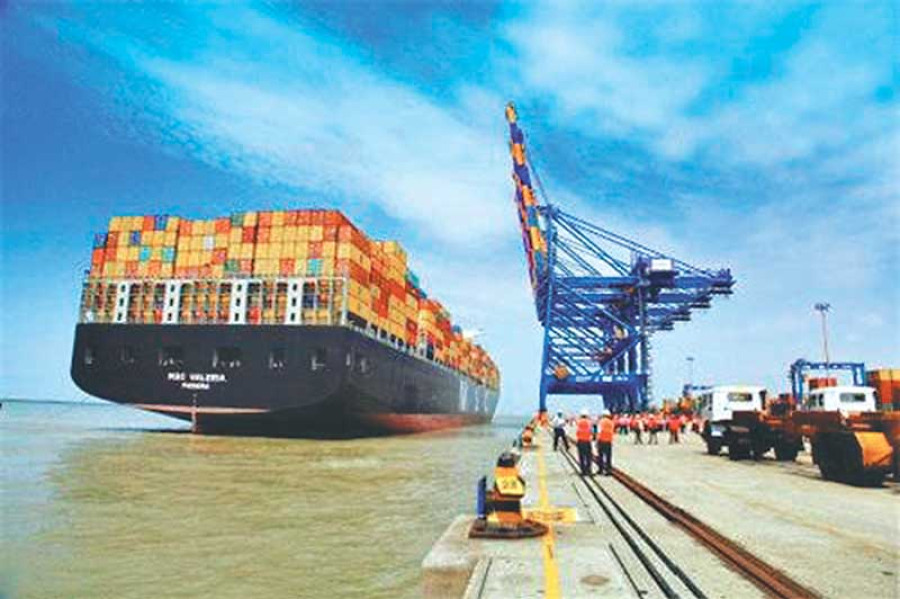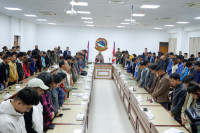Opinion
Emerging transit dynamics
Private sector ports are making attractive offers to Nepali overseas traders
Achyut Wagle
The two and a half decade-long economic reform in India has led to a number of tangible achievements, one of which is the rise of a free market-like competition. The reform process is increasingly providing a larger role to the private sector as investors, developers, producers and market players—even in the services sector. Shipping and transport services fall into this category. India’s neighbours—such as Nepal—also stand to gain an advantage as the former gradually loosens public sector control in its trade of goods and services.
Dawn of a new era
India is not only Nepal’s largest trade partner accounting for more than two-thirds of total international trade, it is also, for all practical purposes, the sole transit country for Nepal-bound goods. A recent estimate suggests that about 92 percent of Nepal-bound cargoes, whether they originate in India or not, transit through Indian land (6 percent enter from or via China and 2 percent by air). Nepal’s export trade, however small, also largely takes place through the two Indian ports of Kolkata and Haldia. Interestingly, a major portion of Nepal’s trade with China also takes place via the Kolkata port. Kolkata and Haldia are riverine ports, at a distance of 130km and 230km from the sea, respectively. Due to their shallow draft of 7 to 10 meters depending on the tide, both of these ports can accommodate only smaller daughter vessels.
As an alternative to the Kolkata port, Nepal has been envisaging the use of the Vishakhapatnam port—more trendily known as Vizag—for about a decade now. A decade ago, New Delhi granting access to this additional passage to sea was portrayed as a great favour to Nepal. But in recent times, a more business-like approach seems to have dawned, thanks largely to the impact of economic reforms and growing business clout of the private sector.
Now, the Vizag port authorities are prepared to compete so as to divert Nepal’s sea cargo business from Kolkata to Vishakhapatnam. Vishakha Container Terminal is a private firm. It is all set to provide a competitive edge to Nepali importers and exporters. As a private company, its orientation is naturally based on profit over (geo)politics.
Vizag-Birgunj distance is exactly double the Kolkata-Birgunj rail route of 668km. But as both the Kolkata and Haldia ports cannot handle mother vessels, the per unit shipment cost of goods tends to be higher. The trans-shipment processing is allegedly impossible without clearing agents and even unauthorised brokers. As such, additional and huge hidden costs are unavoidable—it sometimes takes two to three weeks to unload a ship due to congestion and rush. The logistics and demurrage charges often run amok.
Vizag port authorities and facility operators are now offering to make their new, state-of-the-art digital technology-assisted transit services more attractive both in terms of cost and time. Their aim is to offset the additional transport cost incurred due to the extra distance of 700km in comparison to the distance between Kolkata and Birgunj. For this, they propose three key strategies: efficiency, transparency and promptness. Perhaps the most attractive of all the offers is a promise to include Birgunj in the Bill of Lading as the clearing destination for imports and loading for exports. This is unlike the existing general practice in Kolkata.
Slow going
Things are moving alarmingly slowly, though. After one and a half years of signing an agreement that officially allows Nepali businesses to use the Vizag port, only one rake (cargo train) with 90 containers was delivered to Birgunj a month ago by shipping cargo giant Maersk. The next one is tentatively scheduled for the last week of July.
Now, the transit service business appears to be spreading its wings beyond the government sanctioned bilateral mechanism. Private sector ports are making more attractive offers to Nepali overseas traders. Dhamra port developed by the Adani Group in Odisha is one such private sector port making such offers. It is only 940km away from Birjunj, can accommodate mother vessels and is known for swift techno-based operation. As a private entity, Dhamra port has the potential to bring about a new era of direct business-to-business dealings between the parties of the two countries while limiting the governments’ involvement so they only provide general guidelines instead of being directly involved in the deals. Of course, some meaningful groundwork is necessary in order for these shifts in the Nepal-India transit paradigm to materialise.
It may be a bitter truth, but we have to accept the fact that the multilateral frameworks like South Asian Free Trade Area (Safta) etc have not worked in regard to the Nepal-India trade and transit relations. Bilateralism is the norm and it is likely to remain so for the foreseeable future. As such, Nepal-India treaties and agreements which provide the basis for bilateral trade and transit must also be able to address new realities stemming from globalisation, liberalisation and pervasiveness of digital technology.
The two countries have dozens of agreements and exchange of protocols on trade, transit, rail service, tariff, quarantine, etc. But these have often served more as hurdles than facilitators. For example, one clause of a treaty has made it mandatory for Nepal-bound cargo to be containerised. Such flaws make the import of non-containerised goods like coal, metal ores and clinkers hugely difficult. With an emphatic presence of the private sector in cargo and port services, the bilateral legal instruments also need to be adjusted to these realities. They must reflect an era of open trade and transit.
Paranoia surrounding BRI
Transport infrastructure, both in quantity and quality, has always been a major bottleneck in Nepal-India trade. It has had a direct bearing on the price of goods. Whether it is Kolkota, Haldia, Vizag or (possibly) Dhamra, transporting goods by road is never a financially attractive proposition. The only feasible alternative is the broad-gauge rail connectivity, but this is only limited to a couple of border entry points. Other cargo-related infrastructures—except in the Birgunj container depot—are absent.
The present Indian government of Narendra Modi is employing the ‘neighbourhood first’ and ‘regional connectivity’ policies as the main vehicles of its diplomacy. These theoretical concepts could be translated into reality by creating dedicated rail-line connectivity to at least four major Nepali land ports. This would also help to mitigate India’s paranoia, if any, surrounding China’s Belt and Road Initiative.
Wagle, a founding editor of the economic daily Arthik Abhiyan, is an eco-political analyst




 11.12°C Kathmandu
11.12°C Kathmandu










